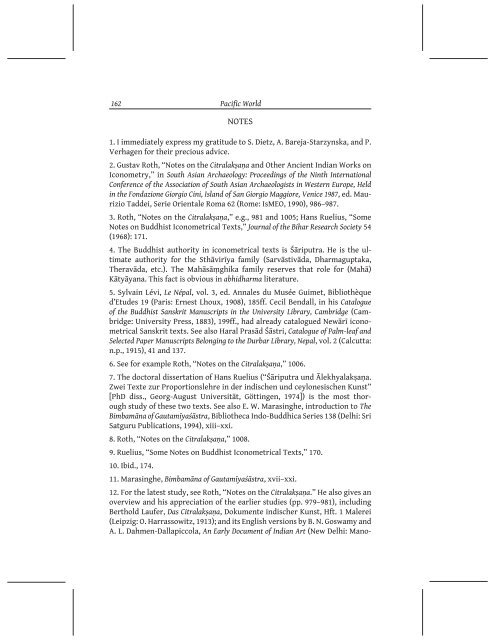download - The Institute of Buddhist Studies
download - The Institute of Buddhist Studies
download - The Institute of Buddhist Studies
Create successful ePaper yourself
Turn your PDF publications into a flip-book with our unique Google optimized e-Paper software.
162<br />
Pacific World<br />
notes<br />
1. I immediately express my gratitude to S. Dietz, A. Bareja-Starzynska, and P.<br />
Verhagen for their precious advice.<br />
2. Gustav Roth, “Notes on the Citralakṣaṇa and Other Ancient Indian Works on<br />
Iconometry,” in South Asian Archaeology: Proceedings <strong>of</strong> the Ninth International<br />
Conference <strong>of</strong> the Association <strong>of</strong> South Asian Archaeologists in Western Europe, Held<br />
in the Fondazione Giorgio Cini, Island <strong>of</strong> San Giorgio Maggiore, Venice 1987, ed. Maurizio<br />
Taddei, Serie Orientale Roma 62 (Rome: IsMEO, 1990), 986–987.<br />
3. Roth, “Notes on the Citralakṣaṇa,” e.g., 981 and 1005; Hans Ruelius, “Some<br />
Notes on <strong>Buddhist</strong> Iconometrical Texts,” Journal <strong>of</strong> the Bihar Research Society 54<br />
(1968): 171.<br />
4. <strong>The</strong> <strong>Buddhist</strong> authority in iconometrical texts is Śāriputra. He is the ultimate<br />
authority for the Sthāvirīya family (Sarvāstivāda, Dharmaguptaka,<br />
<strong>The</strong>ravāda, etc.). <strong>The</strong> Mahāsāṃghika family reserves that role for (Mahā)<br />
Kātyāyana. This fact is obvious in abhidharma literature.<br />
5. Sylvain Lévi, Le Népal, vol. 3, ed. Annales du Musée Guimet, Bibliothèque<br />
d’Etudes 19 (Paris: Ernest Lhoux, 1908), 185ff. Cecil Bendall, in his Catalogue<br />
<strong>of</strong> the <strong>Buddhist</strong> Sanskrit Manuscripts in the University Library, Cambridge (Cambridge:<br />
University Press, 1883), 199ff., had already catalogued Newārī iconometrical<br />
Sanskrit texts. See also Haral Prasād Śāstri, Catalogue <strong>of</strong> Palm-leaf and<br />
Selected Paper Manuscripts Belonging to the Durbar Library, Nepal, vol. 2 (Calcutta:<br />
n.p., 1915), 41 and 137.<br />
6. See for example Roth, “Notes on the Citralakṣaṇa,” 1006.<br />
7. <strong>The</strong> doctoral dissertation <strong>of</strong> Hans Ruelius (“Śāriputra und Ālekhyalakṣaṇa.<br />
Zwei Texte zur Proportionslehre in der indischen und ceylonesischen Kunst”<br />
[PhD diss., Georg-August Universität, Göttingen, 1974]) is the most thorough<br />
study <strong>of</strong> these two texts. See also E. W. Marasinghe, introduction to <strong>The</strong><br />
Bimbamāna <strong>of</strong> Gautamīyaśāstra, Bibliotheca Indo-Buddhica Series 138 (Delhi: Sri<br />
Satguru Publications, 1994), xiii–xxi.<br />
8. Roth, “Notes on the Citralakṣaṇa,” 1008.<br />
9. Ruelius, “Some Notes on <strong>Buddhist</strong> Iconometrical Texts,” 170.<br />
10. Ibid., 174.<br />
11. Marasinghe, Bimbamāna <strong>of</strong> Gautamīyaśāstra, xvii–xxi.<br />
12. For the latest study, see Roth, “Notes on the Citralakṣaṇa.” He also gives an<br />
overview and his appreciation <strong>of</strong> the earlier studies (pp. 979–981), including<br />
Berthold Laufer, Das Citralakṣaṇa, Dokumente indischer Kunst, Hft. 1 Malerei<br />
(Leipzig: O. Harrassowitz, 1913); and its English versions by B. N. Goswamy and<br />
A. L. Dahmen-Dallapiccola, An Early Document <strong>of</strong> Indian Art (New Delhi: Mano-
















